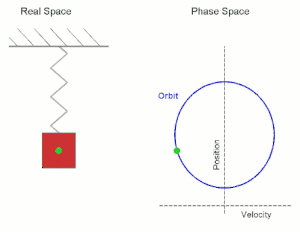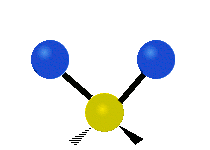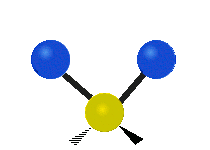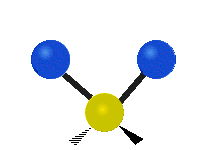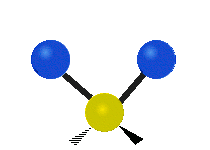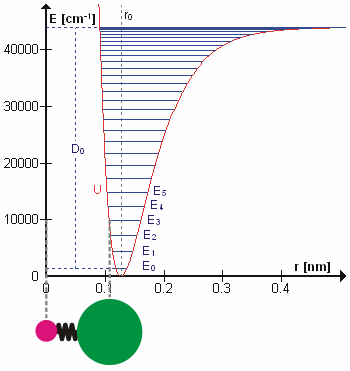From Wikipedia, the free encyclopedia

Schrödinger's cat: a cat, a flask of poison, and a
radioactive source are placed in a sealed box. If an internal monitor (e.g.
Geiger counter)
detects radioactivity (i.e. a single atom decaying), the flask is
shattered, releasing the poison, which kills the cat. The Copenhagen
interpretation of quantum mechanics implies that after a while, the cat
is
simultaneously alive and dead. Yet, when one looks in the box, one sees the cat
either alive
or dead not both alive
and
dead. This poses the question of when exactly quantum superposition
ends and reality collapses into one possibility or the other.
Schrödinger's cat is a
thought experiment, sometimes described as a
paradox, devised by Austrian physicist
Erwin Schrödinger in 1935.
[1] It illustrates what he saw as the problem of the
Copenhagen interpretation of
quantum mechanics applied to everyday objects. The scenario presents a
cat that may be simultaneously both alive and dead,
[2][3][4][5][6][7][8] a state known as a
quantum superposition, as a result of being linked to a random
subatomic event that may or may not occur. The thought experiment is also often featured in theoretical discussions of the
interpretations of quantum mechanics. Schrödinger coined the term
Verschränkung (
entanglement) in the course of developing the thought experiment.
Origin and motivation
Life-size cat figure in the garden of Huttenstrasse 9, Zurich, where
Erwin Schrödinger lived 1921–1926. Depending on the light conditions,
the cat appears either alive or dead.
Schrödinger intended his thought experiment as a discussion of the
EPR article—named after its authors
Einstein,
Podolsky, and
Rosen—in 1935.
[9] The EPR article highlighted the strange nature of
quantum superpositions, in which a quantum system such as an
atom or
photon can exist as a combination of multiple states corresponding to different possible outcomes. The prevailing theory, called the
Copenhagen interpretation, said that a quantum system remained in this superposition until it interacted with, or was
observed by, the external world, at which time the superposition
collapses
into one or another of the possible definite states. The EPR experiment
showed that a system with multiple particles separated by large
distances could be in such a superposition. Schrödinger and Einstein
exchanged letters about Einstein's EPR article, in the course of which
Einstein pointed out that the state of an
unstable keg of
gunpowder will, after a while, contain a superposition of both exploded and unexploded states.
To further illustrate, Schrödinger described how one could, in
principle, create a superposition in a large-scale system by making it
dependent on a quantum particle that was in a superposition. He proposed
a scenario with a cat in a locked steel chamber, wherein the cat's life
or death depended on the state of a
radioactive
atom, whether it had decayed and emitted radiation or not. According to
Schrödinger, the Copenhagen interpretation implies that
the cat remains both alive and dead
until the state is observed. Schrödinger did not wish to promote the
idea of dead-and-alive cats as a serious possibility; on the contrary,
he intended the example to illustrate the absurdity of the existing view
of quantum mechanics.
[1] However, since Schrödinger's time, other
interpretations of the mathematics of quantum mechanics have been advanced by physicists, some of which regard the "alive and dead" cat superposition as quite real.
[8][5]
Intended as a critique of the Copenhagen interpretation (the prevailing
orthodoxy in 1935), the Schrödinger's cat thought experiment remains a
defining
touchstone
for modern interpretations of quantum mechanics. Physicists often use
the way each interpretation deals with Schrödinger's cat as a way of
illustrating and comparing the particular features, strengths, and
weaknesses of each interpretation.
Thought experiment
Schrödinger wrote:
[1][10]
One can even set up quite ridiculous cases. A cat is penned up in a
steel chamber, along with the following device (which must be secured
against direct interference by the cat): in a Geiger counter,
there is a tiny bit of radioactive substance, so small, that perhaps in
the course of the hour one of the atoms decays, but also, with equal
probability, perhaps none; if it happens, the counter tube discharges
and through a relay releases a hammer that shatters a small flask of hydrocyanic acid. If one has left this entire system to itself for an hour, one would say that the cat still lives if meanwhile no atom has decayed. The first atomic decay would have poisoned it. The psi-function
of the entire system would express this by having in it the living and
dead cat (pardon the expression) mixed or smeared out in equal parts.
It is typical of these cases that an indeterminacy originally
restricted to the atomic domain becomes transformed into macroscopic
indeterminacy, which can then be resolved by direct observation. That
prevents us from so naively accepting as valid a "blurred model" for
representing reality. In itself, it would not embody anything unclear or
contradictory. There is a difference between a shaky or out-of-focus
photograph and a snapshot of clouds and fog banks.
Schrödinger's famous
thought experiment poses the question, "
when
does a quantum system stop existing as a superposition of states and
become one or the other?" (More technically, when does the actual
quantum state stop being a
linear combination
of states, each of which resembles different classical states, and
instead begin to have a unique classical description?) If the cat
survives, it remembers only being alive. But explanations of the EPR
experiments that are consistent with standard microscopic quantum
mechanics require that macroscopic objects, such as cats and notebooks,
do not always have unique classical descriptions. The thought experiment
illustrates this apparent paradox. Our intuition says that no observer
can be in a mixture of states—yet the cat, it seems from the thought
experiment, can be such a mixture. Is the cat required to be an
observer, or does its existence in a single well-defined classical state
require another external observer? Each alternative seemed absurd to
Einstein, who was impressed by the ability of the thought experiment to
highlight these issues. In a letter to Schrödinger dated 1950, he wrote:
You are the only contemporary physicist, besides Laue,
who sees that one cannot get around the assumption of reality, if only
one is honest. Most of them simply do not see what sort of risky game
they are playing with reality—reality as something independent of what
is experimentally established. Their interpretation is, however, refuted
most elegantly by your system of radioactive atom + amplifier + charge
of gunpowder + cat in a box, in which the psi-function of the system
contains both the cat alive and blown to bits. Nobody really doubts that
the presence or absence of the cat is something independent of the act
of observation.[11]
Note that the charge of gunpowder is not mentioned in Schrödinger's
setup, which uses a Geiger counter as an amplifier and hydrocyanic
poison instead of gunpowder. The gunpowder had been mentioned in
Einstein's original suggestion to Schrödinger 15 years before, and
Einstein carried it forward to the present discussion.
Interpretations of the experiment
Since
Schrödinger's time, other interpretations of quantum mechanics have
been proposed that give different answers to the questions posed by
Schrödinger's cat of how long superpositions last and when (or
whether) they collapse.
Copenhagen interpretation
The most commonly held interpretation of quantum mechanics is the Copenhagen interpretation.
[12]
In the Copenhagen interpretation, a system stops being a superposition
of states and becomes either one or the other when an observation takes
place. This thought experiment makes apparent the fact that the nature
of
measurement,
or observation, is not well-defined in this interpretation. The
experiment can be interpreted to mean that while the box is closed, the
system simultaneously exists in a superposition of the states "decayed
nucleus/dead cat" and "undecayed nucleus/living cat", and that only when
the box is opened and an observation performed does the
wave function collapse into one of the two states.
However, one of the main scientists associated with the Copenhagen interpretation,
Niels Bohr,
never had in mind the observer-induced collapse of the wave function,
so that Schrödinger's cat did not pose any riddle to him. The cat would
be either dead or alive long before the box is opened by a conscious
observer.
[13]
Analysis of an actual experiment found that measurement alone (for
example by a Geiger counter) is sufficient to collapse a quantum wave
function before there is any conscious observation of the measurement,
[14] although the validity of their design is disputed.
[15] The view that the "observation" is taken when a particle from the nucleus hits the detector can be developed into
objective collapse theories.
The thought experiment requires an "unconscious observation" by the
detector in order for waveform collapse to occur. In contrast, the
many worlds approach denies that collapse ever occurs.
Many-worlds interpretation and consistent histories
The quantum-mechanical "Schrödinger's cat" paradox according to the
many-worlds interpretation. In this interpretation, every event is a
branch point. The cat is both alive and dead—regardless of whether the
box is opened—but the "alive" and "dead" cats are in different branches
of the universe that are equally real but cannot interact with each
other.
In 1957,
Hugh Everett
formulated the many-worlds interpretation of quantum mechanics, which
does not single out observation as a special process. In the many-worlds
interpretation, both alive and dead states of the cat persist after the
box is opened, but are
decoherent
from each other. In other words, when the box is opened, the observer
and the possibly-dead cat split into an observer looking at a box with a
dead cat, and an observer looking at a box with a live cat. But since
the dead and alive states are decoherent, there is no effective
communication or interaction between them.
When opening the box, the observer becomes entangled with the cat, so
"observer states" corresponding to the cat's being alive and dead are
formed; each observer state is
entangled or linked
with the cat so that the "observation of the cat's state" and the
"cat's state" correspond with each other. Quantum decoherence ensures
that the different outcomes have no interaction with each other. The
same mechanism of quantum decoherence is also important for the
interpretation in terms of
consistent histories. Only the "dead cat" or the "alive cat" can be a part of a consistent history in this interpretation.
Roger Penrose criticises this:
I wish to make it clear that, as it stands, this is far from a
resolution of the cat paradox. For there is nothing in the formalism of
quantum mechanics that demands that a state of consciousness cannot
involve the simultaneous perception of a live and a dead cat.[16]
However, the mainstream view (without necessarily endorsing
many-worlds) is that decoherence is the mechanism that forbids such
simultaneous perception.
[17][18]
A variant of the Schrödinger's cat experiment, known as the
quantum suicide machine, has been proposed by cosmologist
Max Tegmark.
It examines the Schrödinger's cat experiment from the point of view of
the cat, and argues that by using this approach, one may be able to
distinguish between the Copenhagen interpretation and many-worlds.
Ensemble interpretation
The
ensemble interpretation
states that superpositions are nothing but subensembles of a larger
statistical ensemble. The state vector would not apply to individual cat
experiments, but only to the statistics of many similarly prepared cat
experiments. Proponents of this interpretation state that this makes the
Schrödinger's cat paradox a trivial matter, or a non-issue.
This interpretation serves to
discard the idea that a single physical system in quantum mechanics has a mathematical description that corresponds to it in any way.
Relational interpretation
The
relational interpretation
makes no fundamental distinction between the human experimenter, the
cat, or the apparatus, or between animate and inanimate systems; all are
quantum systems governed by the same rules of wavefunction
evolution,
and all may be considered "observers". But the relational
interpretation allows that different observers can give different
accounts of the same series of events, depending on the information they
have about the system.
[19]
The cat can be considered an observer of the apparatus; meanwhile, the
experimenter can be considered another observer of the system in the box
(the cat plus the apparatus). Before the box is opened, the cat, by
nature of its being alive or dead, has information about the state of
the apparatus (the atom has either decayed or not decayed); but the
experimenter does not have information about the state of the box
contents. In this way, the two observers simultaneously have different
accounts of the situation: To the cat, the wavefunction of the apparatus
has appeared to "collapse"; to the experimenter, the contents of the
box appear to be in superposition. Not until the box is opened, and both
observers have the same information about what happened, do both system
states appear to "collapse" into the same definite result, a cat that
is either alive or dead.
Objective collapse theories
According to
objective collapse theories,
superpositions are destroyed spontaneously (irrespective of external
observation) when some objective physical threshold (of time, mass,
temperature,
irreversibility,
etc.) is reached. Thus, the cat would be expected to have settled into a
definite state long before the box is opened. This could loosely be
phrased as "the cat observes itself", or "the environment observes the
cat".
Objective collapse theories require a modification of standard
quantum mechanics to allow superpositions to be destroyed by the process
of time evolution.
Applications and tests
Schrödinger's cat quantum superposition of states and effect of the environment through decoherence
The experiment as described is a purely theoretical one, and the
machine proposed is not known to have been constructed. However,
successful experiments involving similar principles, e.g. superpositions
of
relatively large (by the standards of quantum physics) objects have been performed.
[20] These experiments do not show that a cat-sized object can be superposed, but the known upper limit on "
cat states" has been pushed upwards by them. In many cases the state is short-lived, even when cooled to near
absolute zero.
- A "cat state" has been achieved with photons.[21]
- A beryllium ion has been trapped in a superposed state.[22]
- An experiment involving a superconducting quantum interference device
("SQUID") has been linked to the theme of the thought experiment: "The
superposition state does not correspond to a billion electrons flowing
one way and a billion others flowing the other way. Superconducting
electrons move en masse. All the superconducting electrons in the SQUID
flow both ways around the loop at once when they are in the
Schrödinger's cat state."[23]
- A piezoelectric "tuning fork" has been constructed, which can be
placed into a superposition of vibrating and non vibrating states. The
resonator comprises about 10 trillion atoms.[24]
- An experiment involving a flu virus has been proposed.[25]
- An experiment involving a bacterium and an electromechanical oscillator has been proposed.[26]
In
quantum computing the phrase "cat state" often refers to the special entanglement of
qubits wherein the qubits are in an equal superposition of all being 0 and all being 1; e.g.,

Extensions
Wigner's friend
is a variant on the experiment with two human observers: the first
makes an observation on whether a flash of light is seen and then
communicates his observation to a second observer. The issue here is,
does the wave function "collapse" when the first observer looks at the
experiment, or only when the second observer is informed of the first
observer's observations?
In another extension, prominent physicists have gone so far as to suggest that astronomers observing
dark energy
in the universe in 1998 may have "reduced its life expectancy" through a
pseudo-Schrödinger's cat scenario, although this is a controversial
viewpoint.
[29][30]

 is given by
is given by ,
therefore a pendulum of the same length on the Moon would swing more
slowly due to the Moon's lower gravitational field strength. Because the
value of
,
therefore a pendulum of the same length on the Moon would swing more
slowly due to the Moon's lower gravitational field strength. Because the
value of  varies slightly over the surface of the earth, the time period will
vary slightly from place to place and will also vary with height above
sea level.
varies slightly over the surface of the earth, the time period will
vary slightly from place to place and will also vary with height above
sea level.